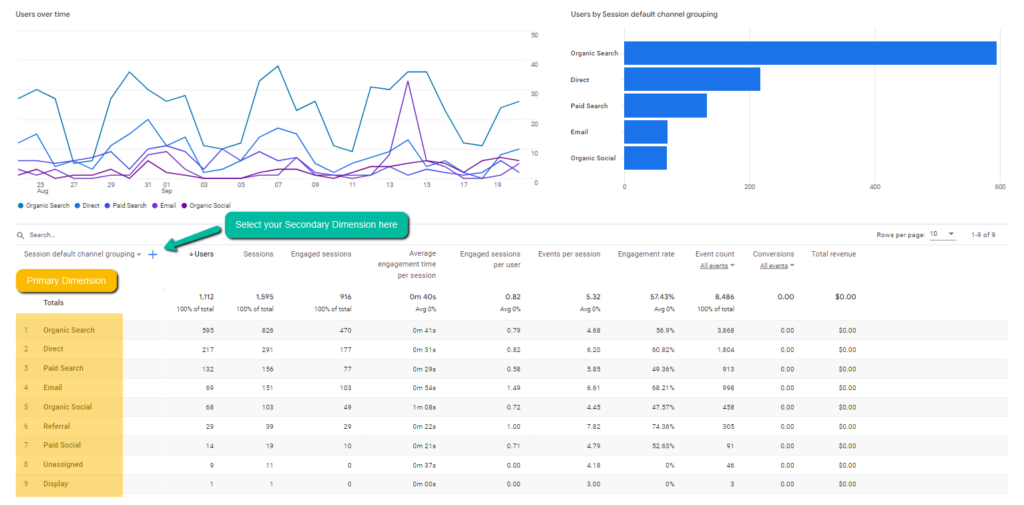Maximize Coverage Accuracy With Second Dimension in Google Analytics
Recognizing exactly how to maximize reporting accuracy with additional measurements in Google Analytics can significantly improve the deepness of insights stemmed from information analysis. By including additional measurements purposefully, marketing experts can discover surprise patterns and connections that might not be instantly noticeable when analyzing main metrics alone. This nuanced technique allows an extra comprehensive understanding of individual habits and project efficiency, paving the method for even more targeted and effective decision-making. The usage of additional measurements holds the vital to opening a wealth of important info that can change the performance of electronic advertising and marketing methods.
Recognizing Additional Measurements in Google Analytics
To enhance information evaluation and gain much deeper insights into customer actions, comprehending second dimensions in Google Analytics is essential. Secondary dimensions allow users to sector and additionally explore data past the primary dimension picked. By integrating secondary dimensions, experts can fine-tune their records to disclose even more in-depth information about individual communications on an internet site. While the main dimension might present the complete number of page sights, adding a second dimension such as 'source/medium' can provide insights into where the web traffic originated from. This extra layer of information allows online marketers to evaluate the performance of different marketing campaigns or networks in driving traffic to the web site.
Moreover, comprehending secondary dimensions is critical for creating extra personalized records customized to specific company objectives. By picking the best mix of key and secondary measurements, analysts can discover patterns, patterns, and relationships that could otherwise remain concealed. This nuanced strategy to data analysis equips services to make educated choices based upon a comprehensive understanding of individual actions throughout various dimensions.

Just How to Apply Secondary Measurements
When leveraging secondary measurements in Google Analytics, the useful application includes choosing specific data parameters to more fine-tune insights beyond the key dimension's range. To apply secondary measurements successfully, begin by accessing the report or dataset where you desire to delve deeper right into the data. Remember that second dimensions aid supply context and granularity to your main dimension information, enabling you to extract even more meaningful and workable understandings from your Google Analytics reports.
Leveraging Second Dimensions for Insights
Utilizing additional measurements in Google Analytics enables a more extensive evaluation of data, offering useful insights beyond the key dimension's extent. By leveraging secondary measurements, users can dig much deeper into the efficiency metrics of their website or app, uncovering surprise patterns and trends that may not be quickly obvious when just taking a look at key dimensions.
One trick advantage of utilizing second dimensions is the ability to section and filter information extra specifically. This can aid analysts and online marketers much better recognize the behavior of details customer segments, such as new visitors versus returning visitors, or traffic coming hop over to these guys from different geographical places.
Moreover, secondary dimensions allow individuals to compare and comparison numerous data factors within the very same report, supplying a much more all natural sight of efficiency (Secondary Dimension in Google Analytics). As an example, coupling the main measurement of landing web pages with second measurements like gadgets or demographics can expose which pages are most effective in engaging individuals on various gadgets or from different demographic teams.
In essence, leveraging additional dimensions in Google Analytics empowers customers to remove richer insights from their data, resulting in even more enlightened decision-making and inevitably, enhanced performance.
Ideal Practices for Additional Dimensions
When examining information in Google Analytics, integrating second measurements efficiently enhances the deepness of understandings derived from the key metrics. Choosing appropriate secondary dimensions assists in giving context and a clearer understanding of the data being taken a look at.
Furthermore, it is suggested to limit the variety of second measurements used in a single record to stay clear of frustrating the evaluation with as well much info. Concentrating on a few essential additional measurements Learn More at once can cause even more actionable and focused insights. Furthermore, think about explore various mixes of second and key measurements to reveal special fads and patterns that might not appear when checking out the information in seclusion.
Advanced Evaluation Methods With Additional Dimensions
Exploring elaborate data relationships through the tactical application of secondary dimensions can unveil nuanced insights that elevate the deepness of evaluation in Google Analytics. By incorporating additional dimensions with primary information collections, innovative evaluation methods can be utilized to extract valuable details. One such strategy is cohort evaluation, where second measurements enable for the segmentation of users right into teams sharing usual features. This technique allows a deeper understanding of customer habits patterns in time, assisting in the recognition of patterns and the assessment of marketing projects' efficiency.
Furthermore, secondary measurements can enhance the evaluation of conversion paths by supplying extra context. Recognizing the different touchpoints a user engages with before converting can be essential in enhancing the consumer journey - Secondary Dimension in Google Analytics. By making use of secondary measurements to delve into specifics such as website traffic sources or tools utilized, marketing professionals can customize techniques to target high-converting networks effectively
Final Thought

To boost data analysis and gain much deeper understandings into individual actions, comprehending second measurements in Google Analytics is necessary - Secondary Dimension in Google Analytics. Secondary dimensions enable customers to segment and even more study information past the primary dimension chosen. While the main dimension may show the total number of page sights, including a second measurement such as 'source/medium' can provide insights into where the web traffic stemmed from.When leveraging second measurements in Google Analytics, the sensible application involves selecting particular information criteria to more improve understandings past the key measurement's extent. Bear in mind that secondary dimensions help provide context and granularity to your primary dimension information, allowing you to remove even more workable and purposeful understandings from your Google Analytics navigate to this site records